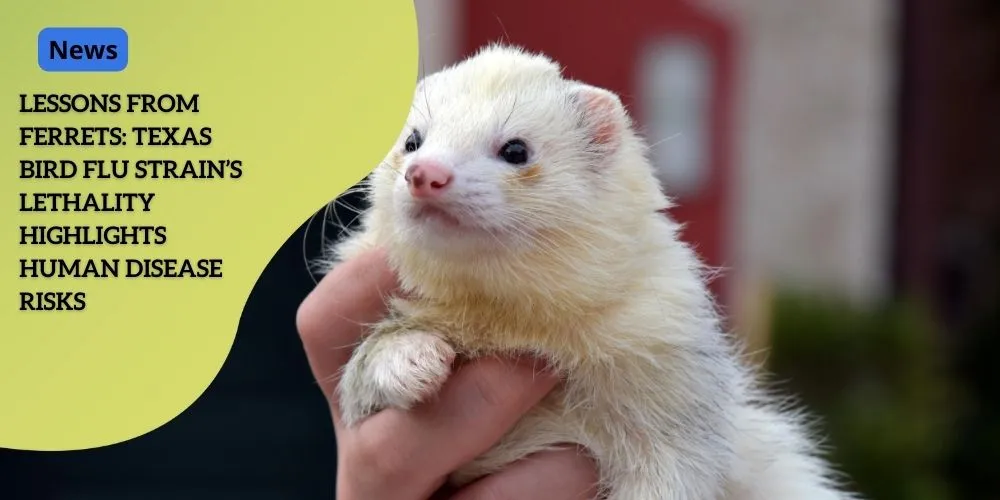Lessons from Ferrets: Texas Bird Flu Strain’s Lethality Highlights Human Disease Risks

Anúncios
The Texas Bird Flu Outbreak
Since late March, over 80 dairy herds across 11 U.S. states have found themselves in the grip of the (A)H5N1 avian influenza virus. This sweeping outbreak has not only impacted livestock but has also sparked concerns about potential human-adaptive changes to the virus. The first alarm rang when a worker on a Texas dairy farm became infected, highlighting a crucial intersection between animal and human health.
Expanding Reach Across the States
The outbreak’s scale is nothing short of significant, having affected dairy herds from Texas to other key dairy-producing states. This widespread issue demands diligent monitoring and response measures from both agricultural and public health sectors to prevent further spread and to establish a clear understanding of the virus’s behavior in various environments.
Anúncios
Case of Human Infection
The key incident driving concerns was the infection of the Texas dairy worker. Although human cases remain rare, this particular instance highlights the virus’s ability to breach the species barrier. While only exhibiting mild symptoms, this case has prompted health officials to take a closer look at how the virus could evolve to become more threatening to human health. The potential for the virus to adapt and mutate demands ongoing vigilance and rigorous protective measures.
CDC’s Perspective and Response
The Centers for Disease Control and Prevention (CDC) emphasize the importance of safety protocols for those in close contact with infected animals. The CDC suggests that while the current risk to the general population is low, it is essential not to become complacent. The collaboration between the agricultural and public health sectors remains vital to manage the outbreak effectively. It ensures that comprehensive strategies are in place to both treat and contain the virus.
Anúncios
The Bigger Picture: Why Surveillance Matters
The broader implications of this outbreak underscore the need for robust surveillance systems. With the U.S., Mexico, and Canada confirming a handful of mild human cases of related H5 strains, the necessity of international cooperation and data sharing becomes clear. Vigilance in monitoring the evolution of the virus helps in predicting and preventing potential future shocks to public health.
As this outbreak unfolds, understanding and mitigating the risks associated with it remain a top priority. The ongoing efforts to track the virus’s spread and its capacity to adapt stand at the forefront of this battle against avian influenza.
“`
Ferret Experiments and Findings
Utilizing Ferrets for Influenza Studies
Ferrets are widely recognized as the best small mammal model for studying influenza viruses. Their respiratory systems are similar to humans, making them valuable for understanding how these viruses infect and spread. The U.S. Centers for Disease Control and Prevention (CDC) frequently uses ferrets in experiments to assess the public health risks of emerging flu strains.
Key Experimental Findings
Recent experiments focused on the strain of avian influenza A(H5N1) that infected a worker on a Texas dairy farm. The results were alarming. Unlike seasonal flu, which typically only makes ferrets ill, the Texas bird flu strain proved lethal to them. This significant lethality raises concerns about the potential impact if the virus were to adapt to humans.
Transmission Mechanisms
A significant discovery was the virus’s ability to spread through direct contact among ferrets. When healthy ferrets were placed in proximity to infected ones, the virus spread rapidly. However, it’s worth noting that the virus showed limited airborne transmission. It was less efficient at spreading via respiratory droplets compared to other influenza strains.
Implications for Human Health
The limited airborne transmission in ferrets suggests that the virus would need to mutate to spread easily among humans. The CDC emphasizes the critical need for protective measures, urging people in contact with infected birds to adopt precautionary steps.
Continued Collaboration and Surveillance
To curtail the virus’s spread and prevent potential human cases, ongoing cooperation between public health authorities and agricultural sectors is essential. Surveillance remains a priority, ensuring any human-adaptive changes in the virus are promptly detected and managed. The ferret experiment’s findings underscore the need for vigilance. While the immediate threat to humans may be low, the situation calls for refined protective measures and robust monitoring to stay ahead of any possible viral evolution.
“`
Implications for Human Disease Risk
The recent studies using ferrets have shed light on the potential human disease risks associated with the Texas bird flu strain. The experiments revealed that while the virus is highly lethal to ferrets through direct contact, its limited airborne transmission suggests that it would need to undergo significant changes to spread efficiently among humans
Protective Measures and Precautions
The Centers for Disease Control and Prevention (CDC) emphasizes the importance of protective measures for individuals who have close contact with infected birds. This includes wearing appropriate personal protective equipment (PPE) such as gloves, masks, and goggles to minimize exposure to the virus. The CDC also recommends regular health screenings for workers in affected areas to ensure early detection and prompt response in the event of infection.
Collaborative Efforts
To effectively mitigate the virus’s spread, continued collaboration between public health authorities and agricultural sectors is crucial. This partnership involves coordinated surveillance of bird populations and rapid response strategies to manage outbreaks. Agricultural workers and public health officials must remain vigilant and share information in real-time to prevent further transmission.
Surveillance and Monitoring
Ongoing surveillance is vital to monitor potential human-adaptive changes in the virus. The Texas bird flu outbreak has already impacted over 80 dairy herds across 11 U.S. states, amplifying the need for rigorous monitoring protocols. Such efforts will help detect any mutations that might increase the virus’s ability to spread among humans
Human Cases and Health Risk
To date, the U.S., Mexico, and Canada have reported five mild human cases of different H5 strains. One case in Mexico, involving a patient with chronic conditions, unfortunately resulted in death. These instances highlight the importance of maintaining robust health surveillance systems and ensuring that people exposed to infected birds take necessary precautions
Although the current risk to the general public remains low, the findings from ferret studies highlight the need for heightened vigilance. By proactively implementing protective measures and fostering collaboration between public health and agricultural sectors, the risk of human disease from this outbreak can be minimized.
“`
Human Cases and Surveillance
Cases Confirmed in North America
Since the avian influenza A(H5N1) outbreak began impacting dairy herds across the United States in March, health authorities have been vigilant in monitoring for human cases. So far, the United States, Mexico, and Canada have confirmed a total of five mild cases of various H5 strains. In the U.S., the three confirmed cases included mild symptoms such as conjunctivitis (pink eye) and some respiratory issues. Notably, two of these cases involved dairy workers directly exposed to infected animals, with one case occurring in Texas. Tragically, the human mortality from the virus has not been completely absent. In Mexico, one confirmed case resulted in the death of a patient who had preexisting chronic medical conditions. This case reinforces the severity that the virus can potentially pose to humans who are already health-compromised.
Importance of Continued Surveillance
Given the lethal nature of this virus in non-human models like ferrets, it’s critically important to keep a close watch on potential human-adaptive changes. Surveillance efforts need to be robust and ongoing. This is particularly important because ferret studies have shown that while the virus spreads easily through direct contact, it demonstrates limited airborne transmission. However, this could change if the virus mutates, making it easier for human-to-human transmission via respiratory droplets
Measures to Mitigate Spread
The Centers for Disease Control and Prevention (CDC) stresses the importance of rigorous protective measures for those in close contact with infected birds and dairy herds. This includes wearing appropriate personal protective equipment (PPE) and adhering to stringent hygiene protocols to avoid direct exposure to the virus (Source: CDC: Human-Animal Interaction). Equally crucial is the collaboration between public health and agricultural sectors. They must work in tandem to implement biosecurity measures that limit the virus’s spread, preventing it from jumping from animal populations to humans. This cooperative effort is essential in reducing the risk of additional human cases and curbing the pandemic potential of this avian influenza strain.
Looking Ahead
The continued monitoring for signs of human-adaptive changes in the virus is indispensable. Should the virus achieve efficient airborne transmission, it would mark a significant escalation in its threat level. Hence, scientists and public health officials will remain on high alert, scrutinizing every development to preempt any potential outbreak. The lessons learned from this monitoring are critical, not just for controlling this outbreak but for preparedness against future zoonotic disease threats.






